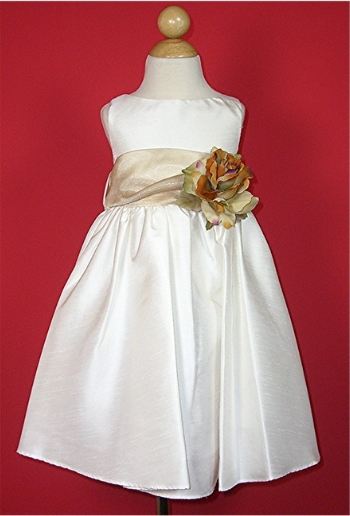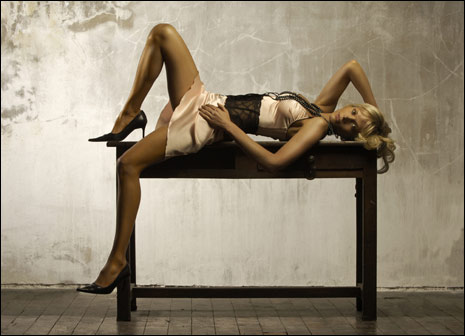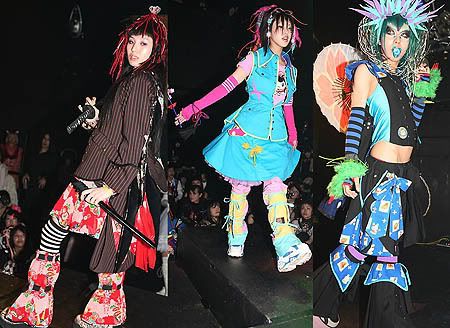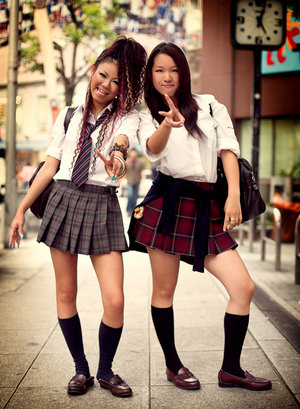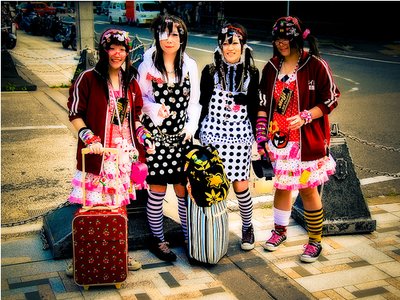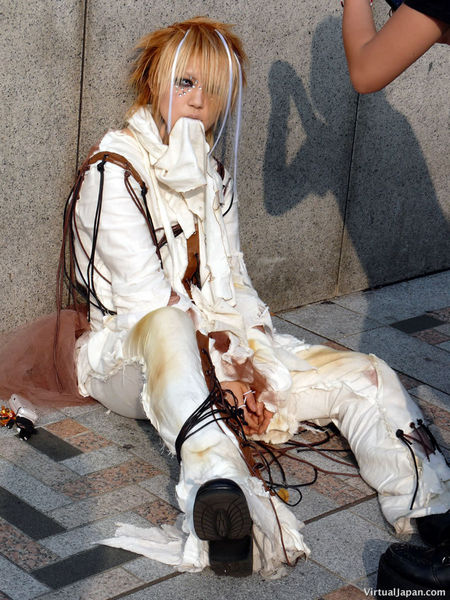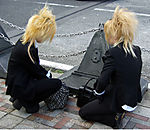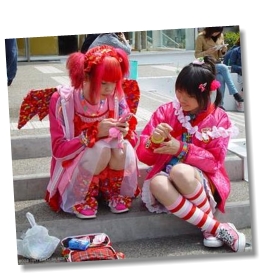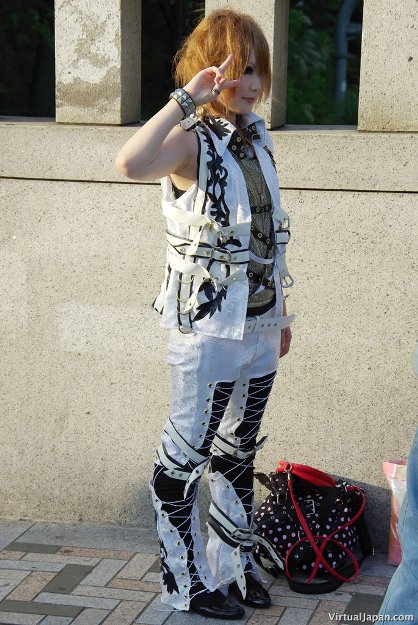
 World Fashion - Japan
World Fashion - JapanJapan occupies an archipelago that stretches for 2,400 km, isolated by the sea from the rest of the world. Its geographic location, as well as the long periods of its political and cultural seclusion, have fueled the conception of its uniqueness. Yet Japan has largely been influenced by neighboring countries, especially China, which prided itself on an ancient and highly evolved civilization when Japan was still living in the Stone Age. It was only natural that Japan would seek guidance from its neighbor in all matters of technology, religion, economy, and even fashion.
Japanese political structure was also influenced by Chinese traditions, though rather ineffectively. Prior to the 7th century AD, Japan was divided up among a number of clans, presided over by an inept emperor. Then, in 645 AD, the Fujiwara clan rose to power and proceeded to forge Japan's destiny.
Junihitoe and the Heian eraBy the 9th century the powerful chief of the Fujiwara clan had been made regent for the reigning emperor. The Heian era (794-1185 AD) had began. Known as the first great peak of Japanese culture, the Heian period was characterized by courtly elegance. Indeed, the aristocracy took great interest in clothing. Japanese noblewomen wore the junihitoe or "12 unlined robes". It consisted of twelve unlined garments of different colors, worn one atop the other in such a manner that a narrow band of each robe was visible at the neck, sleeves and hem.



The layered color patterns of the junihitoe fashion Japan reflected status, seasons, and virtues, among other things. The art of dressing was more highly regarded than moral values and personal traits. It revealed the wearer's artistry and character.
Under the junihitoe, women wore the kosode or "small sleeves". The T-shaped undergarment made of white silk was composed of two rectangular pieces of fabric sewn together at the center back and at the edges. Two additional pieces of fabric were added to the front. The collar and the sleeves, with a small opening for the wrists, were attached at the end. Kosode, the forerunner of the kimono, had to be fitted to the body every time it was put on.
The Heian noblemen wore the dsode or "large sleeves". The large robe had wide sleeves with large wrist openings and was worn with long, full trousers.
Outside the court, people lived a simple, modest life. Peasants could afford only base fibers and the majority had never seen the fine silks worn by nobility. The lavish existence of the elite was met by much criticism from the less privileged provincial clan leaders, which eventually would lead to the fading of the Fujiwara.
Kosode and the Edo eraIn the period 1185-1333 AD power passed to the military dictators known as Shogun. Officially they ruled in the emperor's name, but were in fact independent. Their military retainers were the samurai. Both shogun and samurai lived according to the Zen Buddhist ideals and to dress simply was a virtue. The volume of clothing was reduced layer by layer and the kosode, that was once an undergarment, became the shogun's outer attire. On the other hand, fighting armor was far from simple.
Kyoto natives dressed in the colorful robes and armor of Japan's famous samurai. With the rise of the samurai, the kosode gained popularity, as it symbolized the warriors' humble origins and was more suited to an equestrian, military life.
By the 16th century, articles made in Japan began to appear in Western markets and European merchants became fascinated with the mysterious lands where such magnificent objects were made. The Portuguese were the first Europeans to arrive in 1543. They brought with them food crops from the Americas as well as muskets, which would help put an end to the baronial wars. A new power emerged, the Tokugawa shogunate (1615-1868), whose capital was moved to Edo, today's Tokyo.
It was in the latter part of the Edo period that the kosode's elaboration reached its peak. This was mainly due to the advances in cloth-making techniques such as kasuri (ikat) or resist-dyeing; shibori (tie-dye), in which areas of cloth are tied off before dyeing; yuzen, paste-resist dyed cloth patterned with freehand, brush-applied dyes; and shiro-age, in which the design is reserved entirely by paste-resist dyeing. Designers and artisans also contributed to the elegance and beauty of the kosode by embellishing the monochrome garment with intricate, colorful surface designs.
Women's cosode differed in style according to their social status; Young, single women wore the colorful furisode, a version of the kosode with long, hanging sleeves. The older women's kosode allowed for prescribed changes in sleeve length, patterning and coloration.
The popular sash that holds the kosode in place is called the obi. Prior to the 1680s, this had been a narrow, flat tie or rope-like braid. It was only in the first decades of the 19th century that the obi expanded to reach from under the bust to below the abdomen.
Footwear did not differ for men and women. It consisted of the hemp sandals or wooden clogs known as the geta, and the flat straw-soled sandals, known as the zori. They were all secured to the foot with thongs and worn with white cotton socks or tabi.
The okobo are tall wooden salad worn by the maiko during their apprenticeship. They vary in color according to the maiko status.
Pale skin was aesthetically pleasing and sought after, this is why women would whiten their faces with rice powder. Eyes and mouth were accentuated. Prior to the Meiji Restoration, men also painted their faces with a thick paste of white powder. On the other hand, black symbolized nobility and it was an ancient tradition for men to blacken their teeth.
Headdress was not popular, for women's hair was styled in elaborate fashioned coiffures, adorned with a variety of pins and ornaments, kogai, as well as elaborate combs, kushi. Japanese women wore no other jewelry.
Women from the upper class could go out in public and attend a limited range of leisure activities including the kabuki theater, where one could see and be seen. Both men and women wore their best attire and would change clothing several times during the day-long performances. On the other hand, the kabuki costumes were one of the most striking aspects of the performances. They often set fashion trends in Japan.
The Tokugawa shogunate solidified the power of shoguns over the stratified social system. They ruled over the distinct classes of warriors, farmers, craftsmen, and merchants, officially in the name of the emperor, but in fact had stripped him of his power. Settled in their habits and traditions, shoguns believed that Japan was immune to change and external influence. Their world, however, was already changing. European culture and Christianity with its teachings of universal equality would prove subversive to the established social system.
In the 17th century, Japan initiated a persecution of Christians and Japan withdrew from the outside world. The self-imposed economic and political isolation, which lasted for over two hundred years, was a time of prosperity and peace. Unfortunately, it would have dire consequences. When in the 19th century westerners returned with modern weapons, Japan's obsolete military presented no challenge.
Japan had witnessed the role Europeans had played in the forceful transformation of China and adopted a program of radical change of their own will. Unlike China, they had the means to change. The Tokugawa era had brought economic success, which in its turn had led to a diversified society. The port of Osaka and Edo had been transformed into thriving metropolis and change was already in the air before U.S. Naval Commander Matthew Perry forced open relations with the Japanese in 1853.
The Kimono and the Meiji Restoration
In 1867, the Tokugawa shogunate came to an end and power was restored to the emperor Mutsuhito. The Meiji ("enlightened rule") Restoration had begun. The Japanese government aimed for equality with the West and knew it would have to acieve it on the West's terms. In the first five years Japan adopted a prefectural system of administration, a postal system, a daily newspaper, a ministry of education, a railroad, the Gregorian calendar and military conscription. The samurai warriors joined either the army, under Prussians' leadership, or the navy, advised by the British. Young men were sent abroad to learn the western ways.
One of the innovations adopted from the West was the tailor-made dress. Western-style military uniforms and Western-style business suits were worn in public; they, however, had no place in the privacy of the Japanese home. Traditional-style architectural buildings are carpeted with tatami mats and many activities such as sleeping and eating are performed on the floor. The fitted-costume was inappropriate and rather uncomfortable. Instead, Japanese wore the loosely sashed version of today's kimono.
Kimono or "object of wear" was the word that in the late 1800s replaced the centuries-old term kosode. An accepted explanation for that change of terms is that faced with the cultural shock of finding themselves dressed in western attire, the Japanese felt compelled to find a new name for the historic robe.
Bridal attire includes a white under-kimono, with a black kimono or five-crested haori with haori cords for the groom worn over a hakama, or long pleated skirt of white Sendai silk. The bride wears an uchikake, or quilted robe, often with a pattern of cranes, waves, and pines, as symbols of happiness, with an under-kimono and an elaborately tied obi.
The patterning of each type of kimono is strictly categorized. Styles include the dan ganwri, which consists in alternating blocks of similar motifs; the katami gawariy in which the right and left halves of the kimono bear a different design; or sode gawariy in which each sleeve is differently patterned. Nature is exquisitely present in motifs such as a blizzard of blown blossoms, flowing water patterns, or scattered maple leaves on pine bark.
Female underclothes are just as complex. They include a thin camisole with short sleeves known as hadajuban, a wraparound slip of a light fabric - the susoyoke, and a third under-kimono made from a light, white fabric. Long-stringed rolls, pads, towels and padded vests are used to even out any defects of the body line so the kimono will hang perfectly.
The five-crested haori is another aspect of the tradition lying behind this formal attire. The crests refer to the little circular motifs printed or woven into the haori cloth, representing a person's clan ancestry. Japanese heraldry is older than European and comprises 400 basic family crests, with over 20,000 sublineages.(EzineArticle.com)
Find out the other information on
Spring Dresses.







